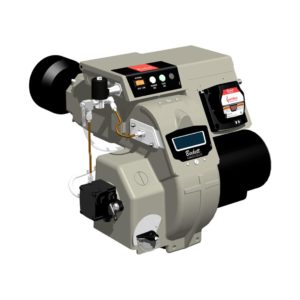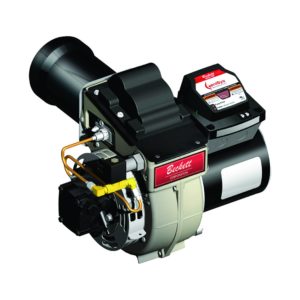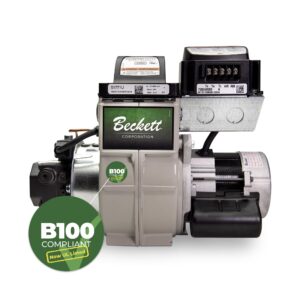In the past few years most oil burner manufacturers have introduced “high static pressure” burners. We have received from our technical subjects’ survey many inquiries regarding the function of and need for these new burners. This technical bulletin will address these subjects.
Review Of Conventional Flame Retention Burners
Conventional flame retention type residential oil burners, such as the Beckett Model AF, have become widely accepted since the late 1960’s. This style of “gun” burner is essentially a specially designed centrifugal fan/blower consisting of a scroll housing and blower wheel onto which components (primary control, transformer, fuel unit, etc.) required for fuel oil combustion are mounted.
The blower provides the volume of air required for combustion of the fuel oil (approximately 34 CFM are per 1 GPH firing rate at 10% CO2), at the pressure and velocity required for proper mixing of the fuel and air at the flame retention head. A typical pressure-flow curve as produced by a conventional flame retention burner blower is shown in Figure 1, Curve A.
Appliance Design And Draft
 The traditional guideline for oil fired heating appliance draft regulation is -.01 to -.02″ WC draft overfire and -.03 to -.06″ WC draft in the breeching. The draft “loss” (the difference between overfire and breech draft) is due to the restriction in the heat exchanger of the appliance.
The traditional guideline for oil fired heating appliance draft regulation is -.01 to -.02″ WC draft overfire and -.03 to -.06″ WC draft in the breeching. The draft “loss” (the difference between overfire and breech draft) is due to the restriction in the heat exchanger of the appliance.
This built-in restriction is required for the proper transfer of heat from the products of combustion to the water (boiler) or air (furnace). The burner works against the restriction in the appliance to push the hot flue gases through the heat exchanger, as the draft created by the chimney works to “pull” through those same flue gases.
This restriction can be shown on a load curve, which depicts the draft loss (or static pressure required) for an appliance for a given air flow (CFM) through it. (See Figure 2, Curve A).
The Problem: Highly Restricted Systems
Now let’s look at high static pressure burners and why they are needed. An appliance’s heat exchanger can become partially plugged due to soot accumulation or the draft in the system can be poor due to an inadequate or damaged chimney. The appliance may have a new, high efficiency type heat exchanger. Under these conditions, the restriction in the system is increased, and the load curve is shifted to Curve B of Figure 2.
This means that more static pressure is required for an equivalent flow rate through the heat exchanger. The heat exchangers in some of the new high efficiency appliances are actually designed for a positive pressure overfire instead of the traditional -.01 to -.02 draft overfire.
The blower in a conventional flame retention burner may not be capable of developing the static pressure required to establish a good flame and move the combustion products through the system if the system is highly restricted, especially on starting when the system may be filled with cool, heavy air. The result of this condition may be pulsations (puffing) on start and/or stop, or in the worst cases, pulsations and erratic flame through the entire run cycle.
An Example
At this point, an example may be helpful to demonstrate the effect of heat exchanger restriction on air flow. Start with a typical plastic, soda type drinking straw. Take a deep breath and exhale through the straw as hard as you can. It will probably take about three seconds to completely empty your lungs of air.
Next, take a small coffee stirrer type straw. Take another deep breath and exhale through this straw as hard as you can. This time completely exhaling will probably take about 15 seconds. For the same deep breath, the effort (static pressure) and the time (CFM) required are much greater due to the increased restriction in the coffee stirrer straw.
The Solution
High static pressure burners have been developed to overcome the problems related to restrictive (“tight”) appliances and poor draft conditions. The blower in a high static pressure burner provides a “blast” of high pressure air on start-up to establish a stable flame, and enough pressure to push the products of combustion through the heat exchanger when the chimney draft alone is not sufficient. The high static pressure behind the flame retention head also acts as a heavy-duty shock absorber to resist and absorb any pulsations on start-up, shut-down, or during the running cycle.

Burner blowers can be designed to produce high static pressure in two ways: with larger diameter blower wheels; or with special blower inlet designs.
Larger diameter blower wheels develop higher pressure due to higher effective fan blade tip speed. Special blower inlet designs, as used in the Beckett Models AFG and Turbo 2000, boost static pressure by causing partial recirculation of air from the blower discharge back into the inlet of the blower wheel.
Burners designed with the latest technology can develop static pressures 2 to 3 times higher than in conventional burners. (Figure 1 compares the pressure-flow curve of a conventional burner, Curve A, with a high static pressure burner, Curve B.)
To return to our example, the high static pressure burner is like a well-conditioned athlete who has the strength to exhale powerfully and develop the push (static pressure) to exhale through the restrictive straw (heat exchanger) more quickly and efficiently.
Summary
Conventional flame retention burners work very well in most retrofit and many new appliance installations. But in an application where there may be a poor draft condition, or in some of the new, higher efficiency appliances, high static pressure burners are quite often the answer for clean, quiet and efficient oil combustion.































